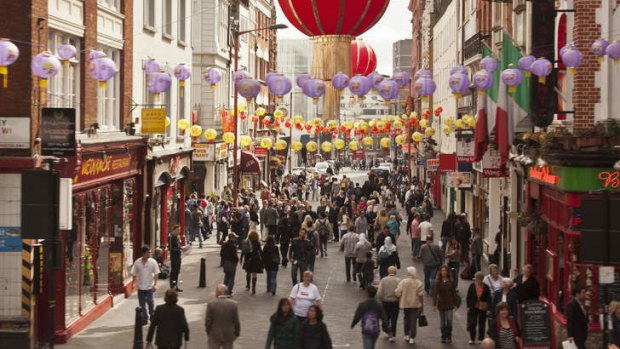
Chinatown in London.
From North America to Europe and Asia, inveterate Sinophile Brian Johnston picks his lucky eight favourite Chinatowns for atmosphere, food and bargain shopping.
I find something irresistibly delightful about Chinatowns. I like the tottering piles of steamed buns in shop windows, and green tea leaves that look like cardboard shavings until they bloom in hot water. I'm seduced by Chinese characters flashing in neon across shopfronts, or looping in gilt on temple walls. I listen to chopsticks clack, duck being sliced with a chop-chop-chop on wooden boards, the "bingqilin!" cry of an ice-cream seller.
What makes a really good Chinatown? It has to provide a distinctive enclave of otherness, which rules out Bangkok, where few of its assimilated Chinatown inhabitants speak Chinese any more, even if little temples peal at every corner and shops are full of Buddhist kitsch. It has to have history, heritage and culture, something not apparent in cities such as Buenos Aires, whose Chinatown was only established in the 1980s by Taiwanese immigrants - though it's still a great place to visit, especially if you long for a vegetarian meal after overdosing on Argentine beef.
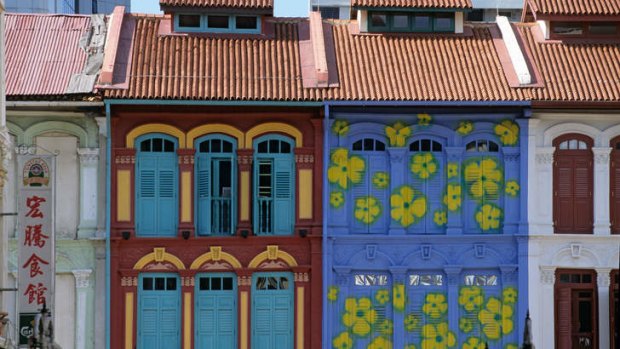
Shopfronts in Singapore.Credit: Alamy
The best Chinatowns must be authentically Chinese: not Japanese as in Sao Paulo, or mostly Vietnamese as in the quartier chinois of Paris's 13th arrondissement, said to be Europe's largest Chinatown. Toronto, too, has a likeable Chinatown but, with its many Indonesian, Korean and Thai restaurants, feels too pan-Asian to be allowed onto my ultimate Chinatown list.
For me, the best Chinatowns are in-your-face Chinese. They aren't polite, pretentious or pretty, but they have strange sights and happy energy. Street vendors rub winter-melons to a sheen, young ladies rub feet to wince-inducing relaxation, chefs puff cigarettes at kitchen doors as cats slink among the dust bins. Convivial restaurants are jammed, shops elbow-jostling, and everywhere daily life unfolds.
NEW YORK
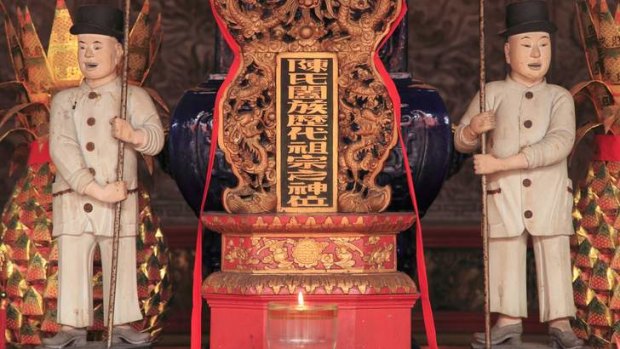
Kuala Lumpur.Credit: Corbis
The largest Chinatown in the Americas lies around Mott Street in Lower Manhattan and is home to about 125,000 Asian immigrants. It's low on aesthetic appeal but has an authentic, lived-in atmosphere and is a prime destination for shopping and eating. Doyers Street, often used as a location for sitcoms and movies, is a good spot for teahouses and dim-sum restaurants.
I like doing breakfast at Big Wong King (67 Mott Street; bigwongking.com), favoured by locals for its congee and steamed rice crepes. For lunch, don't be put off by the uninspiring decor of Great NY Noodletown (28 Bowery Street; greatnynoodletown.com): it has outrageously good seafood noodle soups and salt-baked scallops. For dessert, sample exotic flavours such as black sesame, green tea and wasabe at Chinatown Ice Cream Factory (65 Bayard Street; chinatownicecreamfactory.com).
East Broadway has the most authentic Chinese shopping, ranging from cheap toys and jewellery to quality antiques. Multistorey Pearl River Mart (477 Broadway; pearlriver.com) is crammed with furniture, homeware and bizarre knick-knacks. If you want a Chairman Mao wristwatch or eraser that resembles a sushi roll, you're in luck.
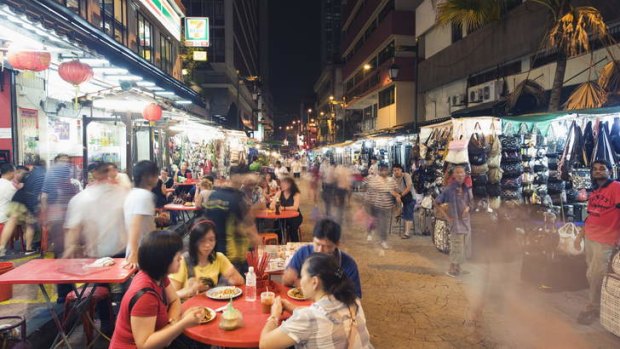
Authentic ways: Kuala Lumpur's Chinatown.Credit: Corbis
See explorechinatown.com.
SAN FRANCISCO
Gates decorated with writhing dragons mark the entrance to what, thanks to Bruce Lee, is probably the world's most famous Chinatown. It was established in the 1850s by gold-rush hopefuls and railway workers, though most of it was rebuilt after the devastating 1906 earthquake.
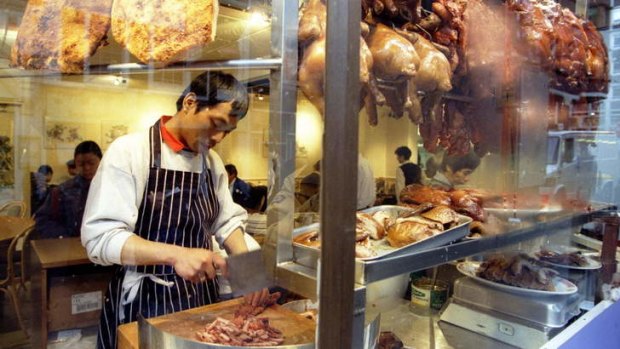
A chef slices duck in London.Credit: Reuters
Recently arrived immigrants still favour this densely populated area, with its bright neon, family-owned shops and wardrobe-size restaurants.
An unbeatable neighbourhood ambience is the main reason to visit, though you could inspect ornate Kong Chow Temple (855 Stockton Street), whose red-and-gold altars overflow with flowers and statues. There's a great view over Chinatown from the fourth-floor balcony.
Drop in at the Fortune Cookie Factory (56 Ross Alley), where, since the 1960s, women at a conveyor belt have been deftly placing messages into hot, flat cookies before twisting them closed over steel rods.
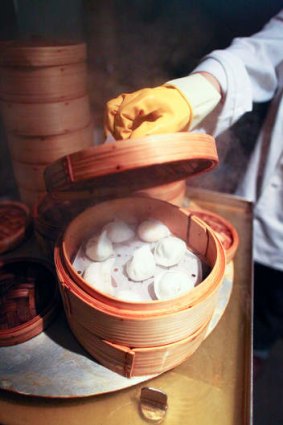
Steamed goodness in London.
You can get personalised messages inserted to surprise dinner-party guests.
Hunan Home's Restaurant (622 Jackson Street; hunanhome.ypguides.net) is the quintessential Chinese eatery with garish pink decor, dusty chandeliers and gulping fish in tanks. The food is perhaps the best Chinese in town; try the prawns with honeyed walnuts.
See sanfranciscochinatown.com.
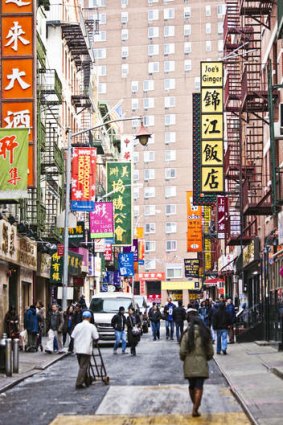
Full of colour: New York's Chinatown.Credit: Istock
VANCOUVER
Vancouver's Chinatown is one of North America's largest, but I find it rather grotty. The main reason to visit is tiny Sun Yat-Sen Gardens (578 Carrall Street; vancouverchinesegarden.com), a tranquil oasis of water and walkways modelled on a famous Suzhou scholar's garden.
Head instead to Richmond, Vancouver's larger and newer (if not officially designated) Chinatown about 30 minutes out of the city centre. Half its population is Asian, mostly from Hong Kong and Taiwan.
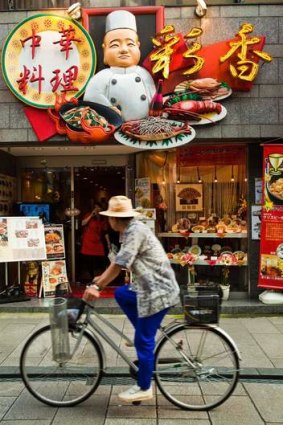
At 150 years old Yokohama has Asia's oldest Chinatown.Credit: Getty Images
The drawcards are huge, Asian-style shopping malls (of which Aberdeen Mall and Yaohan Centre are the best) and up-market restaurants offering the city's most authentic Chinese food. Try dim sum and Cantonese seafood at Shiang Garden (4540 No. 3 Road) or Shanghai-style dumplings and noodles at Shanghai River Restaurant (7831 Westminster Highway).
If you're here in summer, the festive Richmond Night Market (summernightmarket.com) features street performers and food stalls.
Any time of year, don't miss the magnificent International Buddhist Temple (9160 Steveston Highway; buddhisttemple.ca), whose grand architecture and intricate carpentry and stonework is modelled on the Forbidden City. Its courtyards and bonsai garden are a tranquil retreat amid Richmond's energetic bustle.
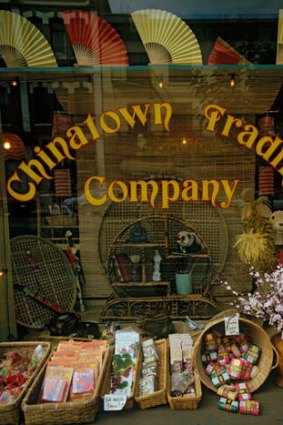
The Chinese artefacts of Canada's Victoria.Credit: Alamy
See tourismrichmond.com.
VICTORIA
Victoria in western Canada boasts the oldest Chinese community in North America; its Chinatown was settled in the 1850s.
Covering only two blocks, it provides a lovely corner of ethnic history in miniature. Fan Tan Alley, just 1.2 metres across, claims to be the world's narrowest commercial street. In the old days, the alley resounded to the click of mah-jong tiles and fan-tan, a gambling game from which it derives its name. These days, it's lined by tiny shops selling handicrafts, musical instruments and Chinese goods.
Chinatown's entrance is marked by the dragon gates and stone lions. Beyond, shops overflow with sacks of soybeans and sea cucumbers. On Sunday mornings, Don Mee Seafood Restaurant (538 Fisgard Street; donmee.com) is packed with dim-sum diners deliberating over trolleys of steamed dumplings and crab claws.
Rambling Chinatown Trading Company (551 Fisgard Street) will sell you anything from bamboo flutes to woks and kung fu outfits.
Silk Road Aromatherapy & Tea Company (1624 Government Street; silkroadteastore.com), run by tea masters trained in China, offers delightful teapots and green tea blends sold loose by the scoopful.
See tourismvictoria.com.
LONDON
No one is quite sure how London's Chinatown got its start, but servicemen returning from the Second World War with a taste for oriental food put it on the tourist map. It's centred on Gerrard and Lisle streets, where telephone boxes and lampposts come with pagoda-like roofs. Few Chinese live in Chinatown, but plenty come to shop. As a tourist there isn't much to buy, but I like browsing the stores, where shelves are pungent with sauces, live crabs struggle in tanks, and deep freezers preserve mysterious dumplings and shrimp balls. On Sunday mornings, extended Chinese families settle in for Sunday brunch amid a happy restaurant hubbub. Humungous Wong Kei (41-43 Wardour Street; wongkeilondon.com), nicknamed Wonky Restaurant, is the true Chinatown experience: expect the best-value Chinese meal in London, dreadful decor and grumpy service that has become something of a legend.
The food in Chinatown was once pretty awful, but has improved enormously in recent years. Enjoy a stellar hotpot at Little Lamb (72 Shaftesbury Avenue), where glowing-faced young Chinese slurp and chat away the afternoon over slippery noodles, paper-thin sliced lamb, and snow crab.
See chinatownlondon.org.
SINGAPORE
Singapore may be mostly Chinese, but there's nonetheless a distinct Chinatown whose early history is traced at the Chinatown Heritage Centre (48 Pagoda Street; chinatownheritagecentre.sg). A top sight is Thian Hock Keng Temple (158 Telok Ayer Street; thian hockkeng.com.sg), where incense burners throw shadowy light and locals pray for lottery luck. Ornate Sri Mariamman Temple (244 South Bridge Road; heb.gov.sg) is an unexpected eruption of multicoloured Hindu gods.
Though currently undergoing renovation, the food stalls of Smith Street are normally the place for Malay rendang curry or Hokkien fried noodles, eaten on rickety red stools. In wonderful contrast, chic bars and nightclubs come alive in the evenings; try Tantric (78 Neil Road), where Qing Dynasty style meets contemporary cool.
Chinatown has several large shopping complexes, such as People's Park, Chinatown Point and Chinatown Plaza. These aren't as swish as those on Orchard Road, sacrificing ambience and airconditioning for bargain prices. Come here for reasonably priced electrical goods, textiles, luggage and cosmetics. For souvenirs, try the Singapore Handicrafts Centre in Chinatown Point (133 New Bridge Road; chinatownpoint.com.sg) for pottery, Chinese lacquer-ware and handicrafts.
See chinatown.sg.
KUALA LUMPUR
Best about this Chinatown, lined by arcaded Anglo-Chinese shop-houses that are cool canyons against the tropical sun, is the energetic vibe. Foot-massage parlours compete with corner restaurants, while an evening bazaar along Petaling Street pulls in crowds hunting down bargain T-shirts, sunglasses, DVDs and "Rolex" watches made in China.
Under the glittering lights of skyscrapers, the old-fashioned hawker centre is the place to tuck into chilli crab, satay sticks or curious but cooling desserts made from red beans.
Visit Chan See Shu Yuen Temple (172 Jalan Petaling), one of the oldest and largest Buddhist temples in Malaysia, where colourful pavilions are decorated with ceramics, woodcarvings and figures from Chinese mythology, some wearing colonial top hats.
Contemporary cool is making an appearance in Chinatown, too. The Warehouse Gallery (198 Jalan Tun HS Lee; thewarehouse.com.my) is a quirky art gallery and cafe with industrial-chic decor and mismatched chairs, while Peter Hoe Beyond (145 Jalan Tun HS Lee) specialises in homeware, jewellery and fashion - check out modern takes on batik. You can have cafe food here too as you recline on silk pillows like a Forbidden City concubine.
See kuala-lumpur.ws/klareas /chinatown.htm.
YOKOHAMA
The largest and liveliest Chinatown in Asia is just a 30-minute train ride from Tokyo. Hordes of visitors cram into the mostly pedestrian streets to browse for Chinese medicines, cheap fashions and toy imports from China. Wander around the eight floors of Yokohama Daisekai (97 Yamashita-cho; daska.jp/english), which has some good souvenir and traditional craft shops, and a food hall themed on 1930s Shanghai.
There were more than 500 restaurants in Chinatown, from banqueting halls to simple stalls serving noodles. Tokyoites come here by the train-carriage-ful in droves just to eat. One of the oldest restaurants, opened in 1893, is Manchin-ro (153 Yamashita-cho; manchinro.com), known for its Cantonese cuisine and steamed dumplings. If you just want to snack, take your pick: shoebox-size stores tempt with black-bean buns, pancakes stuffed with pork and fennel, and an endless gluttony of dumplings.
The district is presided over by the Kantei-byo Shrine (140 Yamashita-cho; yokohama -kanteibyo.com), beautifully decorated and wonderfully illuminated at night. Wander inside and you'll find it's dedicated to the Chinese god of prosperity and business - surely no better presiding deity for a Chinatown.
See chinatown.or.jp/e.
Sign up for the Traveller Deals newsletter
Get exclusive travel deals delivered straight to your inbox. Sign up now.